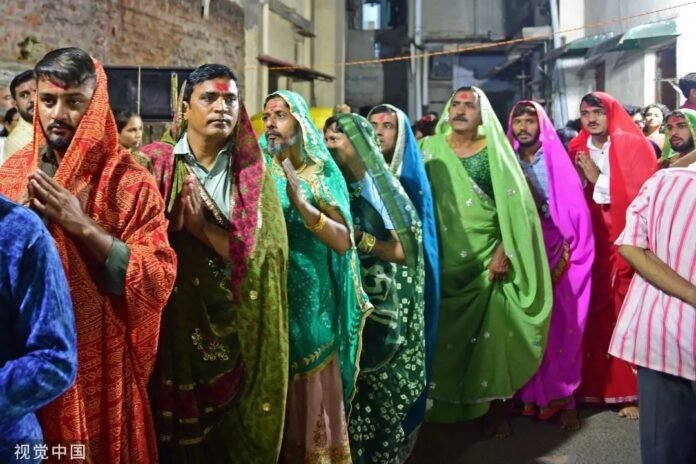
Vaidehi Bhargava
As Navratri celebrations begin across the country on Thursday (October 1), a special tradition in the old city of Ahmedabad stands out. In Sadu Mata Ni Pol, a 200-year-old ritual takes place every year on the eighth night of Navratri. Men from the Barot community wear sarees and perform Garba to honor an ancient curse.
This long-standing tradition represents an act of penance and carries a unique story of devotion and gender-switching customs that have been passed down through generations. The ritual is more than just a dance; it is a deeply rooted practice filled with history, legend, and faith.
In this centuries-old tradition, men dress as women to seek forgiveness for a curse placed on their ancestors by Sadu Mata, a woman whose story has been passed down for generations. According to local lore, over 200 years ago, a woman named Saduben sought protection from the men of the Barot community when a Mughal nobleman demanded her as a concubine.
Unfortunately, the men failed to protect her, resulting in the tragic death of her child. Heartbroken and furious, Saduben cursed the men, proclaiming that their descendants would live as cowards, and then she committed ‘sati’.
Sadu Mata Ni Pol, home to over 1,000 residents, comes to life on the night of Ashtami. With its narrow lanes and old-style houses, the pol is a living piece of Ahmedabad’s heritage. Crowds gather to watch men dressed in sarees, spinning gracefully to the rhythms of Sheri Garba, a traditional folk dance passed down through generations.
A temple was built to calm Sadu Mata’s spirit and break the curse. Every year, on the night of Ashtami, men from the community come together at Sadu Mata Ni Pol, wear sarees, and perform Garba as an act of penance. This tradition, still thriving today, attracts people from all over the city who come to witness this powerful expression of devotion and heritage.
While modern views may link men dressing as women to gender fluidity, for the Barot community, it is a symbolic act of humility and respect. The ritual is seen as a way to atone for past wrongs and to honor the blessings bestowed by Sadu Mata. Men who have prayed for personal wishes—whether for success in business, good health, or the birth of a child—participate in the ritual to give thanks when their prayers are fulfilled.
The Barot community of Gujarat is traditionally known for their role as genealogists, storytellers, and record keepers for various communities. They preserve family histories and maintain oral traditions, particularly for Rajput and Kshatriya families. Historically, they have been responsible for documenting genealogical records and were central in passing down cultural and religious stories through generations. They also performed during festivals, reciting epics and folk tales.Although the Barot community’s traditional roles have evolved over time, they remain a significant part of Gujarat’s cultural heritage. Their unique customs are especially prominent during festivals like Navratri, where these traditions continue to thrive.
One participant shared that he has been wearing a saree for the past five years to express gratitude to Sadu Mata. After praying for success in his business and the blessing of a son, he felt the goddess had favored him. For him, this tradition provides a meaningful link to their heritage, allowing the community to show appreciation for the blessings they receive in their lives.This tradition is not solely about appeasing the curse; for many, it’s a way to honor the goddess they believe has safeguarded and blessed their families for generations. The pol becomes a site of deep devotion, with men of all ages donning vibrant sarees to pay homage to Sadu Mata as an expression of faith.
Ahmedabad, India’s first UNESCO World Heritage City, is renowned for its rich history and traditions. The ritual of men performing Garba in sarees is just one of the many ways the city keeps its cultural heritage alive. Among the 184 pols of the old city, Sadu Mata Ni Pol stands as a symbol of the Barot community’s enduring devotion and resilience.

